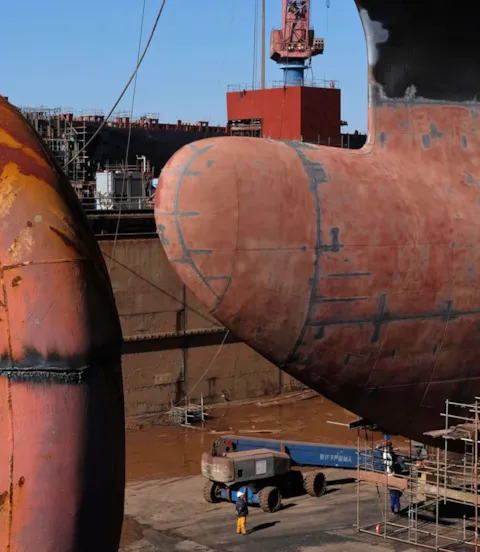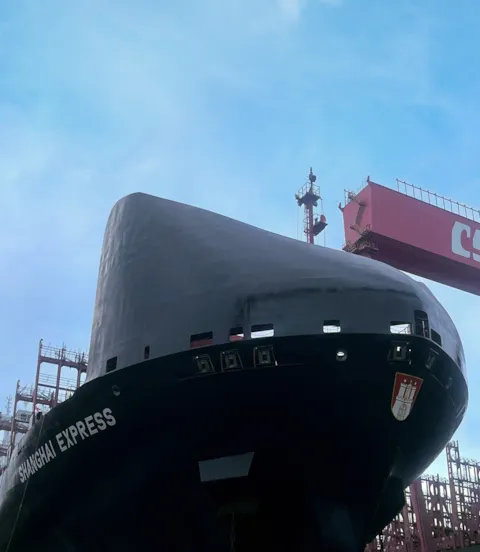Hapag-Lloyd tackles huge fleet upgrade programme with DNV support
In a major fleet upgrade programme Hapag-Lloyd is modifying over 100 container vessels to reduce fuel consumption, emissions and costs per tonne-mile, and maximize cargo capacity. For technical support and evaluation of the different measures they partnered with DNV.
Adapting flexibly to new regulatory and market conditions has always been key to the success of Hapag-Lloyd AG (HLAG), enabling the company to build a legacy of over 175 years. Increasing demand for container transport and new emission rules prompted the container liner company to explore strategies to improve energy efficiency and the cargo carrying capacity of the fleet, which is partly owned and partly chartered.
Joining hands for the Loadability Push
As these plans began to take shape, HLAG asked their long-standing partner DNV to assist with an extensive fleet upgrade within the scope of the company’s Strategy 2030. The corporate goals include positioning HLAG as the “Undisputed Number one for Quality” in the container shipping market and taking the next steps towards HLAG’s sustainability goals of reducing its carbon emissions by one third by 2030 and achieving net-zero by 2045.
The Fleet Upgrade Program as outlined in 2021 endeavours to determine the most economically feasible optimization measures for each ship to minimize operating costs and carbon emissions per tonne-mile and boost its cargo capacity. As the classification society of the relevant vessels, DNV is in charge of ensuring compliance with the latest rules and regulations. In addition, HLAG consulted with DNV’s class-independent Advisory experts, for engineering and technology advice, especially with regard to bulbous bow retrofits. “Our experiences working with DNV on our fleet in service have always been positive,” says Martin Grieger, Director Fleet Upgrade at HLAG. “Furthermore, being both an owner and operator, we’ve a dedicated Fleet Upgrade Team at HLAG that enables us to orchestrate such a project.”
DNV study explores feasibility of optimization measures
The team at DNV’s Container Excellence Center (CEC) in Hamburg has been supporting the initiative from the very beginning. In early 2021, DNV launched a systematic study into the optimization potential of 78 ships representing 11 different series. “DNV carried out calculations to verify the feasibility and potential cargo capacity increase,” Grieger points out.
DNV collected its findings in a comprehensive fleet overview spreadsheet that reflects the implications of four different retrofitting measures for each vessel or class: hull line optimization through modification of the bulbous bow; propeller retrofit; height increase of lashing bridges and deckhouse elevation; and draught increase.

Intricate interdependencies to consider for retrofitting
“All of these measures have short payback times,” explains Jan-Olaf Probst, Executive Vice President Business Development at DNV. “And they’re highly interdependent: retrofitting a new propeller to account for a ship’s reduced cruising speed typically requires modification of the bulbous bow to optimize the flow pattern around the hull and maximize efficiency; and increasing the height of lashing bridges might require an increase of draught, hatch cover reinforcements and in some cases, a deckhouse elevation to maintain the required line of sight. All these factors must be considered ship by ship.”
A good example are the seven T-class vessels modified to generate 900 additional container slots. “This was a compelling business case for us,” underlines Martin Grieger. “We increased the draught, raised up the lashing bridges and even cut off the top of the superstructure to raise it by six metres.”

DNV fleet overview guides the upgrade programme
The fleet upgrade programme is a “dynamic” project, says Grieger. “We’re currently about two thirds through the first leg of the programme, which involves up to 150 individual upgrade measures. This includes more than 100 propeller replacements and up to 50 bulbous bow refits.” HLAG began by reaping the most beneficial investments, adds Martin Grieger. “We try to time these measures so they can be executed whenever these ships – including some we’re operating on long-time charter – are up for the next dry-docking. However, when the business case is especially compelling, we may even dry-dock the vessel specifically for the upgrade,” he says.
The fleet evaluation spreadsheet prepared by DNV continues to guide HLAG’s fleet upgrade activities today and will continue to do so in the foreseeable future, says Grieger. “This matrix tells us directly for each optimization measure and vessel what benefit to expect, based on our current preferred operating patterns,” he explains. “There is a green thumbs-up symbol for measures yielding 10% of savings, a sideways-pointing thumb for 3–5% savings and a downwards thumb for less than 3%. We review this list periodically to check what we’ve achieved so far, and what remains to be done.”
If HLAG were to further reduce cruising speeds at any time in future, the remaining sideways or downwards-pointing thumbs might warrant reconsideration, he adds, so the spreadsheet will continue to be a valuable reference source. “It has been very practical and useful, and it has spared us the tedious effort of having to do all that research in-house.”

Finding the right combination of measures takes both sides’ expertise
DNV also provided assistance with the actual implementation of the measures selected. Using state-of-the-art 3D-based simulations, the experts at the Container Excellence Center calculated the effects of increasing the container stack weights, while DNV Advisory determined the optimal shapes for new bulbous bows and ran hydrodynamic simulations. “Bulbous bow modification is one of the most effective ways of saving fuel and cutting emissions,” notes Dr Olaf Doerk, Head of the Advisory Center in Hamburg. Whenever a ship is to be optimized, a key task is to determine the limiting factor dictating how far the optimization effort can go, adds his colleague Jan-Olaf Probst.
Finding the right combination of measures for a given vessel requires close collaboration with the owner, Probst points out: “It takes both sides’ know-how to determine the best way forward – DNV’s ship engineering and hydrodynamic knowledge and sophisticated tools, and the client’s commercial and operational expertise.” In some cases, says HLAG’s Martin Grieger, a propeller retrofit may not be accompanied by a bulbous bow replacement simply because the commercial equation doesn’t support both. “We always have to look at the yard costs within the ship’s operating region – if the savings do not cover the cost of the measure, the investment isn’t viable.”

Close collaboration enables fast and smooth processes
The fleet upgrade programme enables HLAG to save substantial operating costs, says Grieger. A crucial factor for the success of the project has been the close collaboration between the experts from Hapag-Lloyd AG and DNV, both sides agree. “Speed has been essential in this programme,” stresses Grieger.
DNV has been extremely responsive and is always ready to provide know-how based on its decades of experience, remarks Grieger. “Projects are always prepared well so there are no unpleasant surprises. When we wanted to retrofit bulbous bows on our Dortmund Express-class ships at the end of 2023, where the analysis had shown a saving potential of more than 7 per cent, we had only three months to get it all done. Verify the business case, manufacture the bows, dock the vessels and install the new bulbs. We got a positive response from DNV instantly, and exemplary collaboration. Everything went very fast, and we met the tight deadline.”

Reducing the carbon footprint of world-wide cargo transport
Meanwhile, the discussion is moving to the next phases of the fleet upgrade programme: retrofitting variable-frequency drive pumps for all large electrically driven pumps will reduce energy consumption on board many vessels. Furthermore, in a pilot project HLAG and owner Seaspan will jointly convert five ships to methanol fuel while HLAG is taking steps to secure the supply of bio methanol to power them.
“We’re pursuing all these goals with a certain passion,” Grieger adds. “Because step by step, we’re reducing our carbon footprint while making the transport of goods more efficient and sustainable. That’s a worthwhile goal.”

- Hapag-Lloyd AG
- DNV
- DNV
